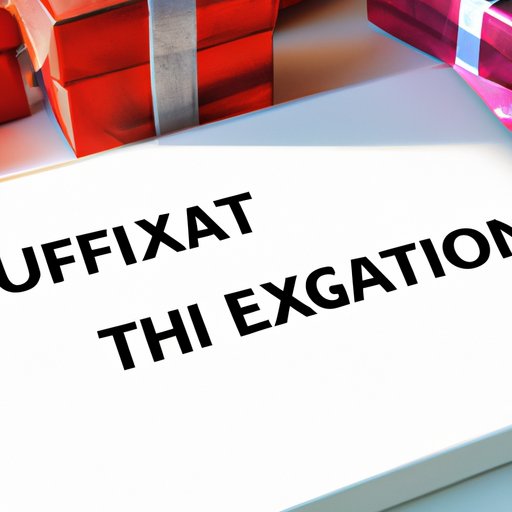
I. Introduction
Many people opt for gifting money to their loved ones for various special occasions throughout the year. However, it can be challenging to navigate the tax implications of gifting money, and it is essential to understand the rules to avoid potential issues. This article explores the annual and lifetime gift tax exclusion limits and provides insight into how much money can be gifted tax-free.
II. Know the Annual Gift Tax Exclusion Limit
The annual gift tax exclusion limit is the maximum amount of money that an individual can gift to another individual in a single year without incurring gift tax. The Internal Revenue Service (IRS) sets the annual limit and is subject to change every year. For 2021, the limit is $15,000 per person.
Any gifts given to an individual under the annual exclusion limit are tax-exempt and will not count towards the donor’s lifetime gift tax exemption.
For example, if Rachel gifts $10,000 to her daughter and $5,000 to her son this year, both gifts will be tax-exempt as they are under the $15,000 annual limit.
III. Understanding the Lifetime Gift Tax Exemption
The lifetime gift tax exemption is the total amount of tax-free gifts an individual can make over their lifetime. The IRS sets the lifetime exemption limit, which is subject to change every year. For 2021, the exemption limit is $11.7 million.
Any gifts given above the annual exclusion limit will be counted towards the donor’s lifetime exemption limit.
For example, if Robert gifts $25,000 to his cousin this year, the gift exceeds the annual exclusion limit of $15,000, making the overage of $10,000 count towards his lifetime exemption limit. If Robert had not used up all his lifetime exemption limit, there would be no gift tax incurred.
The lifetime exemption limit can also be used alongside the annual limit if exceeding the latter.
For instance, if James gifts his granddaughter $100,000 this year, $15,000 of it will be tax-exempt as it is under the annual limit, and the remainder of $85,000 will be deducted from his lifetime exemption limit.
IV. Consider Gift Splitting
Gift splitting is a strategy used by some individuals to maximize the tax-free allowance where the gift is split between two people. For example, if a married couple gifts money to a recipient, they can split the gift evenly, allowing them to apply the annual exclusion limit twice, even though it was given by only one person.
For instance, if John gifts his daughter $20,000 for her wedding, he can split the gift with his wife, allowing them to apply the annual limit twice, thus gifting their daughter $40,000 tax-free.
V. Deducting Gifts in Estate Planning
Gifting now can be a smart strategy for minimizing estate taxes later. Individuals who are concerned about the size of their estate and potential estate taxes can gift money away while they are alive.
One benefit of making gifts while alive is that it reduces the value of the donor’s estate. Hence, when they pass away, they would have fewer assets subject to estate tax.
Furthermore, donors can use gift tax exclusions and deduct such gifts from their estate and gift tax. For example, if Ada gifts her son $50,000 this year and deducts it from her lifetime exemption limit, she will have reduced the size of her estate by that amount, saving her some potential estate taxes.
VI. Gifting Beyond Immediate Family
Gifting to friends and extended family members can also be done tax-free. However, the rules around gifting to these individuals are more complicated and require careful consideration.
The annual exclusion and lifetime exemption limits apply to all individuals that gifts are given to. Therefore, if a person gifts their friend $20,000 this year, $5,000 of it would count towards the annual exclusion limit, leaving $15,000 to count towards their lifetime exemption limit.
However, other rules and limitations apply when giving gifts to non-immediate family members, such as aunts, uncles, or cousins. It is important to seek expert advice before making such gifts.
VII. Penalties for Over-Gifting
Over-gifting can lead to potential penalties and legal issues. The IRS imposes gift taxes for gifts that exceed the annual exclusion and lifetime exemption limits. The tax rate on gifts above these limits ranges from 18% to 40%.
Therefore, it is essential to stay within the limits to avoid potential penalties and legal issues. If a person exceeds the annual exclusion, it is advisable to use their lifetime exemption limit to avoid penalties.
VIII. Conclusion
Gifting money tax-free can be a smart and generous strategy when done within the laws that govern it. It is crucial to understand the annual gift tax exclusion limit and the lifetime gift tax exemption to avoid potential penalties and legal issues.
However, gifting can be an effective part of estate planning and is a practical way to reduce estate taxes later.
If in doubt, it is important to seek expert financial advice to ensure that gifts are made effectively within the limits of the law.





